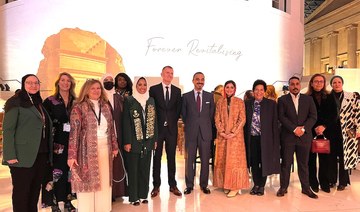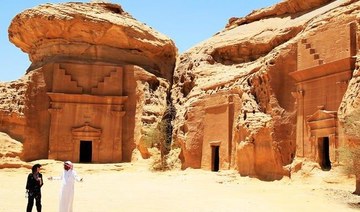Alexandria was known as the Hamptons of Egypt. It was the summer destination for the Egyptian rich, famous and royalty. The beautiful beach shore side and great weather is a major attraction for both locals and tourists.
Mediterranean is a port city in Egypt. During the Hellenistic period, it was home to a storied library and a lighthouse ranking among the Seven Wonders of the Ancient World. Today the library is reincarnated in the disc-shaped, ultramodern Bibliotheca Alexandrina research center. The city has many Greco-Roman landmarks, old-world cafes and European-style parks. Its 15th-century Qaitbay Citadel is now a museum.
1) Montaza Palace and Garden:
The Montaza area is situated along the coast about 20 km east of Alexandria’s old district. The Palace was the late Egyptian King Farouk’s summer palace, this makes it a slightly difficult place to visit for tourists. When they do, they have the opportunity to wander about the grounds of what was once has royal compound. You can get a fairly good view of the building from the various parts of the park, but don’t try to get too close; otherwise you will be warned away by the guards. The park is still well maintained and there are many green spots in which you will find young couples and groups of friends and families having a small picnic and taking photos. The best part of the garden are the views of the city, make sure to take lots and lots of pictures. Once a royal home, it is still part of government property, but the surrounding park can be visited for a small fee and tourists are permitted to get fairly close to the palace in order to take pictures. The palace is typically gaudy, done in a fake Rococo style that, perhaps, emphasizes the king’s dreams of Venetian grandeur, built on the mercantile base of the city.
The palace was supposed to be divided into two buildings. The bigger one was for the wives of King Farouk and the other smaller one was for gentlemen purposes. But for now, the big building is the only one that is still in use for welcoming the guests of Egypt’s president. Wandering through the gardens at Montaza is wonderful, especially in spring and summer when the flowers are in bloom, but even in winter the shrubs and trees are attractive because the gardens have been well landscaped.
2) Bibliotheca Alexandrina :
The Bibliotheca Alexandrina is a major ancient library and cultural center located on the shore of the Mediterranean Sea in the Egyptian city of Alexandria. It was built in the 17th or 18th century. It comprises 3D Science Film, computers, good lights, lots of information, high security and museums all under one roof. This place will offer you an archaic feeling of the Egyptian culture. It is one of the oldest libraries of the Egyptian civilization. The original library has been remodeled but you will get to experience the depths of it. The library has a free half hour guided tour. It also has a hall of manuscripts. The building is very uniquely designed and has 11 levels. Make sure to go to the roof because the view from the top is spectacular. Around the library premises are other attractions like museums and exhibition of paintings and pictures.
3) The Alexandria National Museum:
The Alexandria’s National Museum was inaugurated on Dec. 31, 2003 by the then president Hosni Mubarak and it’s located in a restored Italian style palace in Tariq Al-Horreya Street. The building used to be the US consulate before it turned into a museum. This excellent museum sets a high benchmark for summing up Alexandria’s past; it displays a good variety of archaeological items that were found in the last decade in Alexandria, such as coins and statues recovered from the sea. There are artifacts from Canopus and Herakleion, Islamic artifacts such as doors inlaid with mother-of-pearl, Coptic steel and friezes, tableware, jeweler and medals. In the underground floor, you can also find wrapped mummies and photos can be taken here and in the entire museum.
4) Citadel of Qaitbay (Fort of Qaitbay):
The Citadel of Qaitbay is a 15th-century defensive fortress located on the Mediterranean Sea coast. It was established in 1477 AD by Sultan Al-Ashraf Sayf Al-Din Qa’it Bay. It is said that the Citadel was built on the exact site of one of the Seven Wonders of the Ancient World; the Lighthouse of Alexandria, or Pharos Lighthouse. Some of the stones and bricks from the lighthouse were used to build the Citadel. An earthquake hit Alexandria in the 11th Century and the lighthouse was fully repaired and continued to function. It is now known as Fort Qaitbey, but what made it somehow magic for me was the fact that here the ancient lighthouse of Alexandria was located. Another quake hit in the 14th century, the lighthouse was destroyed completely. The fort was neglected and sat in ruin until 1904, when King Farouk wanted to turn it into a royal palace for himself. In 1952, the Egyptian Navy turned the fort into a Maritime Museum. Most of the restoration took place in 1984.
5) Corniche and downtown area:
One of the biggest attractions in any Arab port city is the corniche. Alexandria like any other Mediterranean city, enjoys an outdoor culture, the people of Alexandria have built up their long corniche with restaurants, hotels, cafés and small shops and bakeries. Groups of families, friends and couples will stroll along the corniche as a form of evening entertainment. If you are lucky, you will be attending a public wedding celebration with the bride and groom dancing at the corniche. The strip of the corniche from Montaza up to Biblioteca Alexandrina is primarily commercial and the beach area below is built for those wishing to spend some time on the sand and in the sun.
As you go closer to the old city and downtown area, the corniche starts showing more and more of a mixture of official buildings, houses of wealthy families and commercial establishments linked to the city’s maritime history.
Downtown Alexandria might be the most popular neighborhood in the city, which is home to the local market. Visitors will often come across narrow and winding alleyways popularly called Zanqet El-Settat or “the women’s squeeze.” These mazes of small streets — too narrow for cars to fit in — are popular among women due to the hundreds of shops selling women’s clothes, accessories and makeup. Many Egyptian women shop there due to the reasonable prices and good quality. Most of the products are Egyptian-made, but Chinese-made products are also becoming more available.
6) El-Mursi Abu Abbas Mosque:
Right across the local market lies “El-Mursi Abu Abbas Mosque,” a beautiful building with huge granite pillars, colored glass skylights, intricately carved wooden windows and doors as well as paved marble floors. Constructed in 1775 by Algerians, it is said to be the biggest mosque in Alexandria and is located amid six other mosques in the same neighborhood. Its beautiful architecture is not to be missed. Women, however, cannot enter the mosque during prayer times.
7) The Roman theater:
What is left of Roman architecture is the Roman theater, also known as “Kom El-Dikka” (which means hill of rubble), which is situated at Ram Station Square. There, you can find the remains of a theater where assemblies were made for the royal audience.
Until archaeologists from the University of Warsaw began to excavate this site in the 1960s, it looked like what the name suggests. Now, after the removal of more than 10,000 cubic meters (340,000 cubic ft.) of earth and the construction of a new building to protect mosaics, “Kom El-Dikka” is an example of the kind of Roman ruins that likely lie under other sections of modern Alexandria.
Though the site is not huge, it comprises a column-lined street, a third century theater with 13 intact tiers of seats that accommodated an audience of 600, and the remains of a villa with a series of truly lovely mosaics on the floor. The mosaics are worth a careful look due to their intricately detailed and colorful depictions of local wildlife. The curve and size of the theater is impressive, but the most amazing thing about it is that it was originally covered with a roof.
8) Royal Jewelry Museum:
Just a few minutes’ drive from the Roman theater there is the Royal Jewelry Museum, which is installed at the Palace of Nobel Fatma El-Zahraa. The palace is a beautiful example of European art and architectural designs. After purchasing a ticket and turning your cell phone off, visitors are required to wear cloth on their shoes to keep the floors clean. Consisting of an eastern and western wing, the two wings are connected to a long balcony made of colored glass.
The museum includes paintings and a huge collection of royal jewelry and home accessories. Most of the jewelry pieces have the owner’s initials carved on them. The museum is a luxurious place where diamonds, gold, silver, crystals, pearls and coral all exist under one roof.
Every season is good to visit Alexandria, there is a beautiful variety of things to do and things to see in this city.
—
Email: [email protected]
Alexandria: Old world charm meets modern style
Alexandria: Old world charm meets modern style

Ryan Reynolds named Abu Dhabi’s Yas Island ambassador
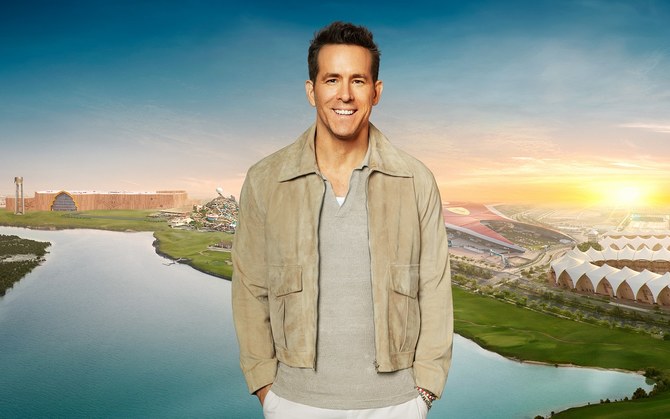
DUBAI: Unmasked as the mystery skydiving celebrity who appeared in a recent teaser campaign for the Abu Dhabi location, Hollywood star Ryan Reynolds is Yas Island’s newest “Chief Island Officer.”
The “Deadpool” actor takes up the role after US actor Jason Momoa, who in turn took over from US comedian Kevin Hart.
In the new promotional video, Reynolds is seen parachuting straight into the heart of the action amidst speeding cars on Yas Marina Circuit, missing his intended landing spot at the W Abu Dhabi.
“I've been an actor, a producer, a Welsh football club owner and I could go on. So I will …" begins Reynolds, but the rest of his speech is drowned out by the roar of F1 cars as they zoom around the circuit.
The trailer also features the actor enjoying the sights and sounds of Yas Island, as he zooms down water slides at Yas Waterworld Abu Dhabi, explores Gotham City and takes rollercoaster rides at Warner Bros. World.
"With the appointment of Ryan Reynolds as our latest chief island officer of Yas Island Abu Dhabi, we continue the tradition of excellence established by Kevin Hart and Jason Momoa. Reynolds brings his own unique blend of charisma, energy, and enthusiasm to the role, promising to elevate the Yas Island experience to even greater heights. We're thrilled to embark on this exhilarating journey with him, inviting fans worldwide to be part of the legacy," said Liam Findlay, chief executive of Miral Destinations.
How the hospitality industry in Saudi Arabia is embracing environmental sustainability
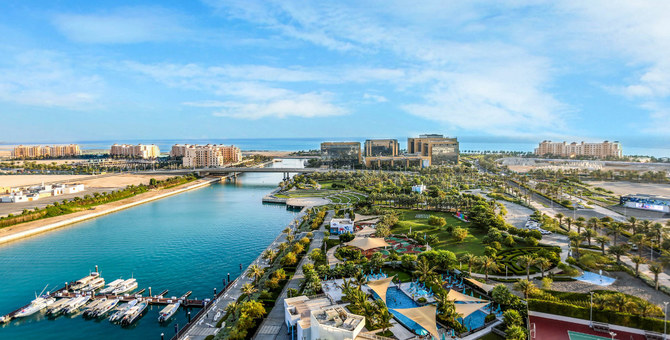
- From the Red Sea coast to Al-Ahsa Oasis, new eco-friendly hotels and resorts are opening across the Kingdom
- Industry leaders are boosting sustainability by cutting emissions, protecting habitats, and creating jobs locally
RIYADH: Saudi Arabia is emerging as a hotspot for international investment. Its latest hook? Sustainable hospitality.
The Kingdom led the Middle East and Africa’s hotel-building activity in 2023, with 42,033 hotel rooms constructed. This accounted for 35.1 percent of the 119,505 built in the region over the year, according to data from hotel monitoring firm STR.
Saudi Arabia’s hotel segment is projected to generate $2.51 billion in revenue this year and is expected to reach $3.02 billion by 2027, according to Statista.
One of the Kingdom’s Vision 2030 goals is to champion sustainability across all sectors, and in turn, hotels and plazas across the country have been working to implement more environmental and eco-friendly practices in their facilities.
From 2010 to 2019, Saudi Arabia’s tourism industry has contributed an average of 6.4 percent to the country’s gross domestic product, while recording a decline in greenhouse gas emissions.
In contrast, the global GDP average for travel and tourism over the same period rose 4.3 percent, and emissions by 2.5 percent.
Several of Red Sea Global’s developments are already up and running along the Kingdom’s northwestern coastline, including the Six Senses Southern Dunes, The Red Sea and St. Regis Red Sea Resort.
The company recently announced further projects pillared by environmental sustainability.
The Four Seasons luxury wellness resort, Amaala, Triple Bay, is branded with regeneration and wellness at its core, and is set to feature a one-of-a-kind Corallium marine life institute.
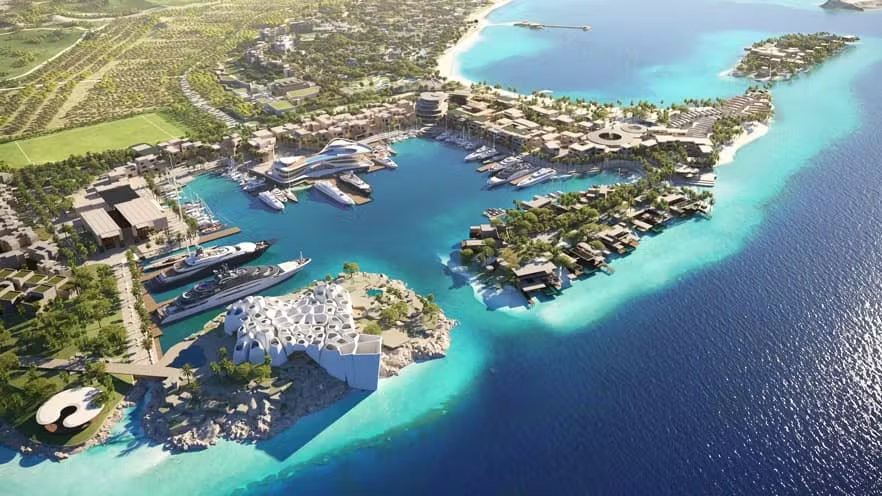
Progress is also being made on a sustainability-focused staff village that will provide housing for those who work at the resort. RSG says that five international operator brands, including Six Senses and Clinique La Prairie, are expected to be confirmed in the coming months.
“Our mission to develop new destinations as beacons of responsible tourism, showcasing the best in sustainable and regenerative development, gains unprecedented urgency as our planet continues to face challenges in relation to the climate crisis and biodiversity loss,” John Pagano, RSG’s group CEO, said in a statement.
The economic zone NEOM recently unveiled three new sustainable hotels in its Leyja oasis, including three flagship Habitas properties, as well as Zardun, a sanctuary resort designed to harmonize with the surrounding ecosystem.
NEOM’s Hotel Development division has also sponsored Hotelschool The Hague to bring about the Sustainable Hospitality Challenge, bolstering a new generation of innovation in the industry.
Many of the resorts across Saudi Arabia are built to blend in with the surrounding environment. Take AlUla’s Habitas, for example, which boasts the city’s serene desert landscape that immerses guests in its untouched backdrop.
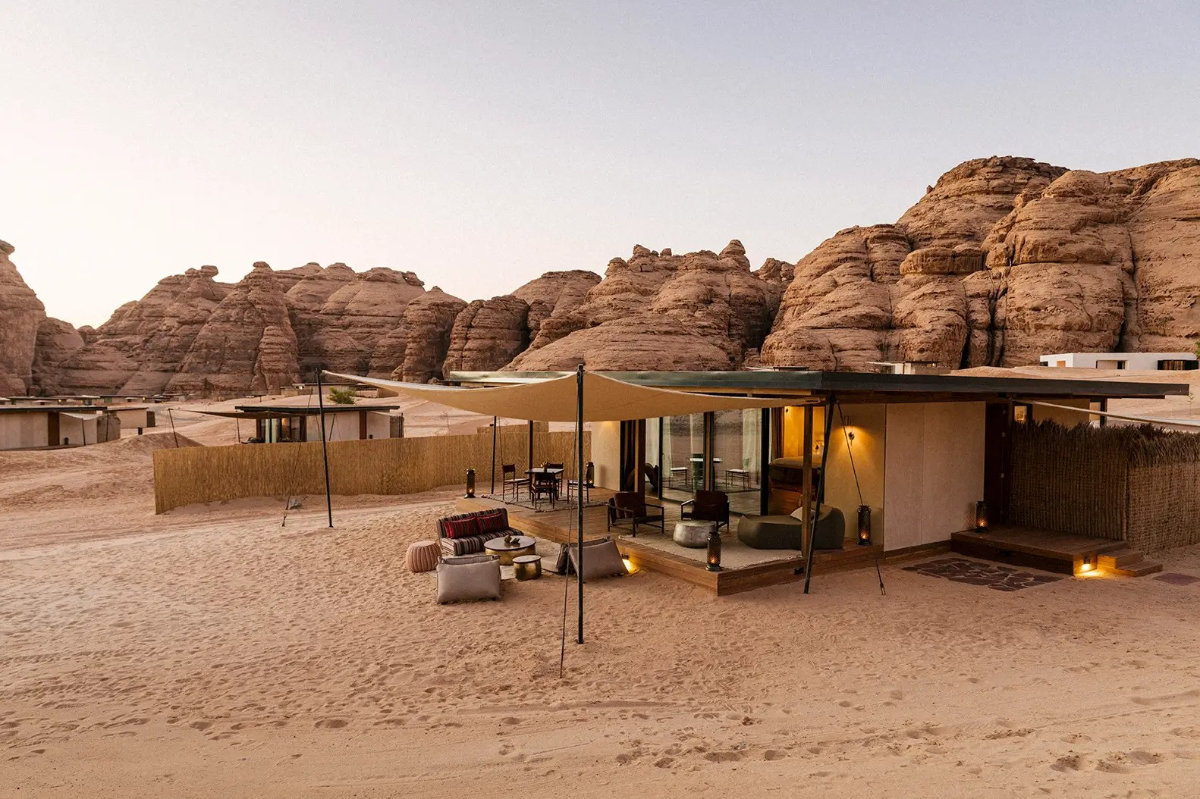
The luxury resort brand demonstrates its sustainable ethos, in line with the UN Sustainable Development Goals for 2030, through the offsetting of carbon emissions, waste management and a single-use plastic free policy.
“The AlUla Sustainability Charter is at the core of every hospitality project we develop within the destination,” Phillip Jones, chief tourism officer at the Royal Commission for AlUla, told Arab News.
“From the foundational design and materials of construction to the infrastructure, and the ongoing operations, as we only work with international operators that have a proven track record in sustainability, AlUla’s hotels and resorts each contribute toward delivering on our goals, such as achieving net carbon neutrality for local emissions by 2035.”
As the Arab region demonstrates overall lower environmental sustainability due to water scarcity, harsh climate and biodiversity threats, industry leaders are redefining the buzz term to fit local standards.
There are a number of grassroots projects that examine the existing traces of environmental sustainability awareness throughout the Arab region’s history. The Kingdom’s forefathers exhibited community-centered lifestyles, for example, while Islam advises its followers to conserve food and water consumption.
Chris Nader, CEO and co-founder of luxury ecolodge brand and management company ENVI Lodges, told Arab News: “Sustainability comes from a basis of trying to minimize our negative impacts on the environment. It’s not only nature, or animals — it’s also people.”
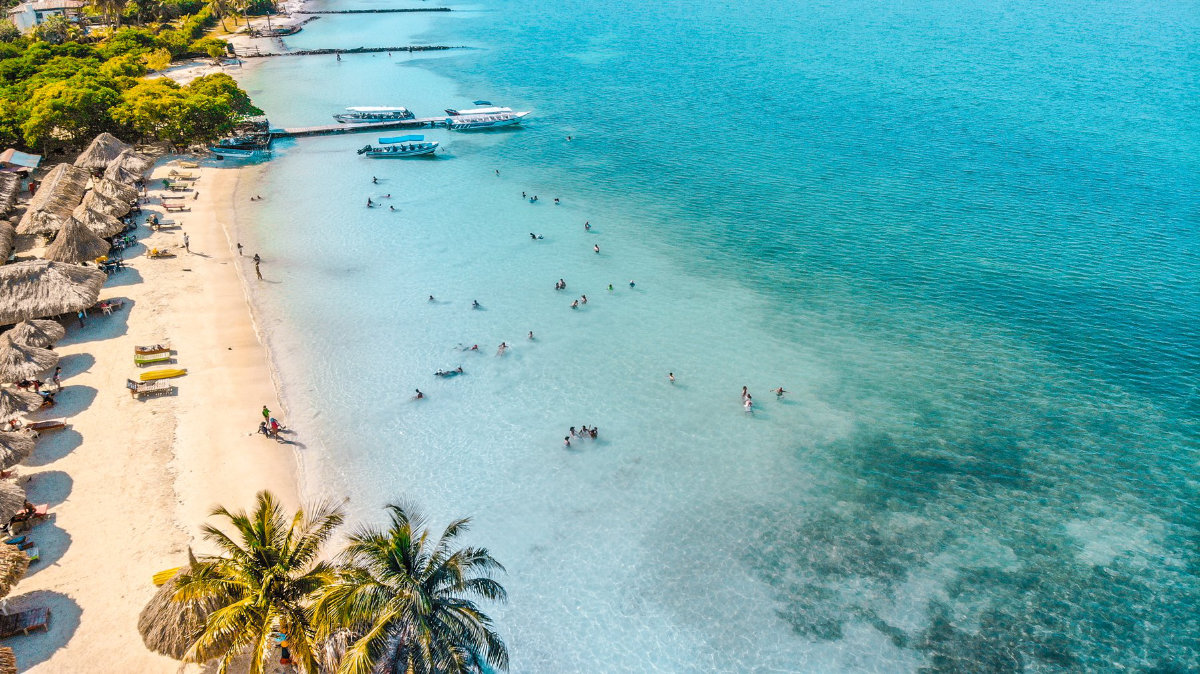
ENVI Laguna Bay, a sustainable project developed by Al-Rasim Hotels and Resorts, will occupy a prime Red Sea coast beachfront destination in King Abdullah Economic City, surrounded by mangroves.
“KAEC will host the first eco-friendly coastal resort in the distinguished and captivating laguna area,” Aiad Mushaikh, CEO of Al-Rasim Hotels and Resorts, said in a statement.
The project strongly aligns with Saudi Arabia’s Vision 2030. Its road map for tourism sector growth includes respecting the land, protecting wildlife, supporting local communities, sourcing mindfully, in-house food production, engaging guests and designing a sense of place. These pillars have been built into the technical guidelines of building the lodge.
One common belief is that building necessitates the destruction of land. But through its design principles, ENVI demonstrates different approaches that can be taken to minimize its presence within the natural landscape. The company builds low-impact lodges that blend into the environment.
“We don’t do excavations,” said Nader. “We put our unit on stilts or decks, and we don’t build the units completely on the site so the amount of people and trucks on the site that have to come and go is very limited.”
An important element is also selecting materials from the environment, whether they be wood, rocks or mud, and sourcing materials and products that will maintain durability and integrity over time.
Opinion
This section contains relevant reference points, placed in (Opinion field)
The company also champions sourcing a percentage of the ingredients used in its kitchens from in-house gardens, developing programs for wildlife protection and hiring staff from local communities, all of which are tailor-made programs for each lodge.
The whole concept is to assume the project is temporary, aiming to leave the landscape more or less in the same state it was found in. The walkways are not poured concrete, and the native species are planted to cross-pollinate.
Another way to stitch sustainable practices within the fabric of the community is to engage guests in the initiative.
“Today, guests don’t want to be spectators,” said Nader. “They don’t want to be told that the lodge is planting mangroves. They want to plant themselves. Guests want to clean the beach, or the lodges, to remove any litter and plastic and all of that. They want to be involved in saving wildlife and caring.”
Saudi Arabia’s Public Investment Fund recently launched Dan Company, which specializes in agritourism and ecotourism. Architecture and design practice LWK + Partners is working on a project with Dan Co. that aims to invigorate the agriculture industry in Al-Ahsa through hospitality, serving as a benchmark for future projects.
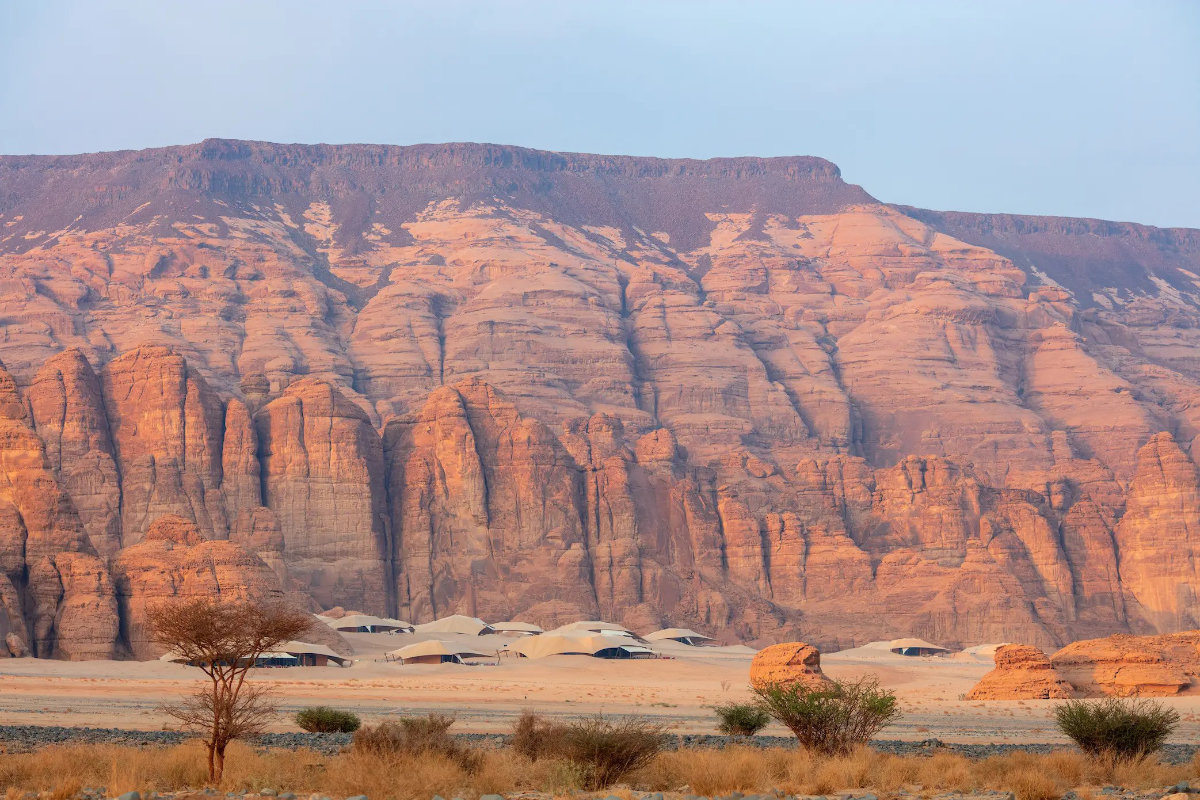
Kerem Cengiz, MENA managing director at LWK + Partners, told Arab News: “Sustainability isn’t just about the reduction of energy; sustainability is also about the way we create places that are harmoniously designed to make the way we interact with them sustainable.
“We look at sustainability as a holistic offering, rather than a series of tick boxes that we need to achieve.
“It really is important that when we design, we don’t have a pattern book; it still saddens me that we’ve seen many buildings going up that are just glass towers. They express a certain language and vision, but are they desirable in the context of the challenges that we’re facing environmentally?”
He added that the key to bridging these sustainable values into the future of the industry is to focus on a fundamental understanding of technology and innovation. How do you put in sensors that turn off the AC when guests leave the room, for example?
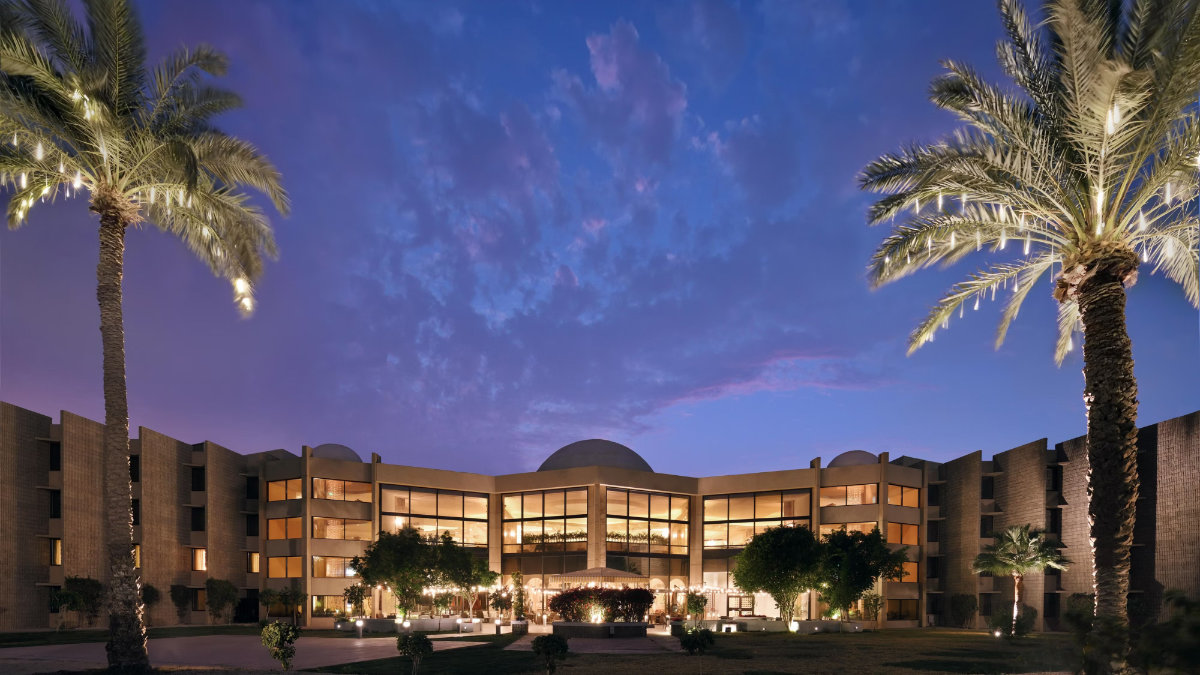
Saudi Arabia is leading the way in many development practices, said Cengiz. The Holiday Inn Tabuk is utilizing solar energy as an alternative power source in some locations, while the InterContinental Jubail carries out voluntary campaigns to clean its beaches.
Like Nader, Cengiz said that private and public developers should move towards sourcing materials that are locally or regionally available. This adds great value not only economically, but also sustainably, by cutting down on products imported from overseas, simultaneously reducing carbon emissions.
He added: “Now, Saudi is developing its own market and its own product lines. I think that, in itself, has a massive impact and I would love to see more attention on that type of thing.
“I think we’re way past the 2030 Vision now. I mean, we’re evolving it much further into something significantly more impactful.”
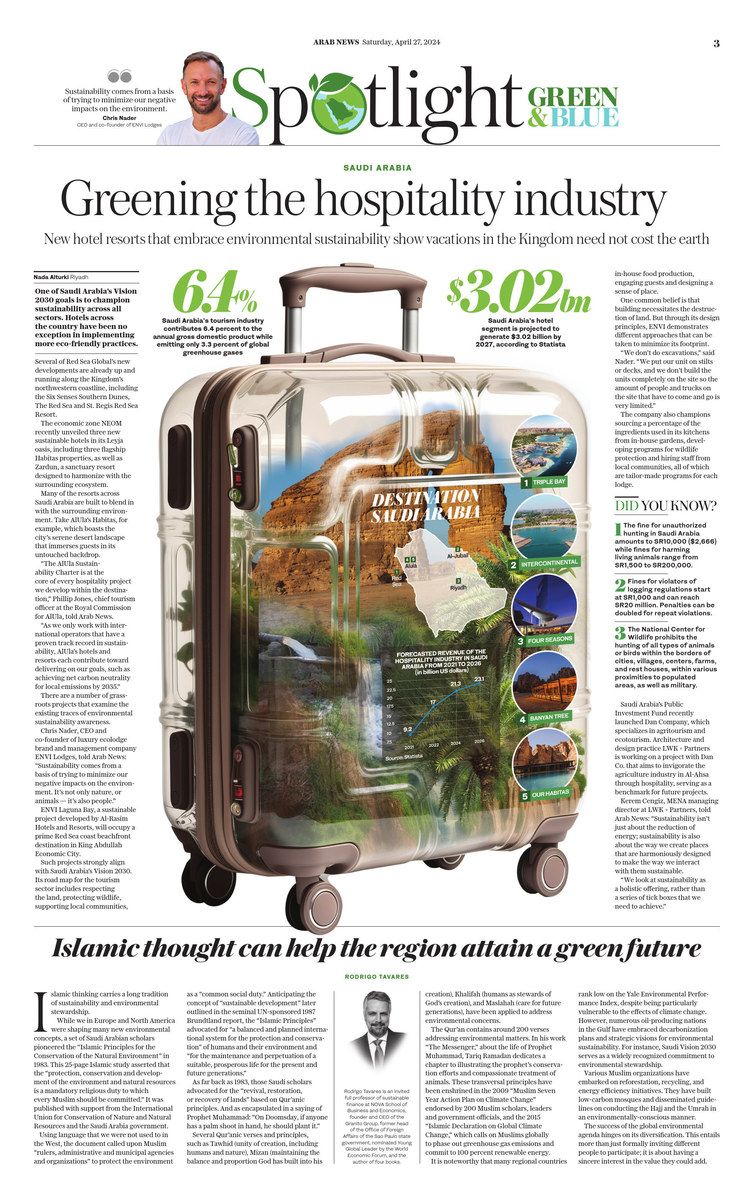
Two Saudi hotels listed in Conde Nast’s Hot List of new openings from the last year
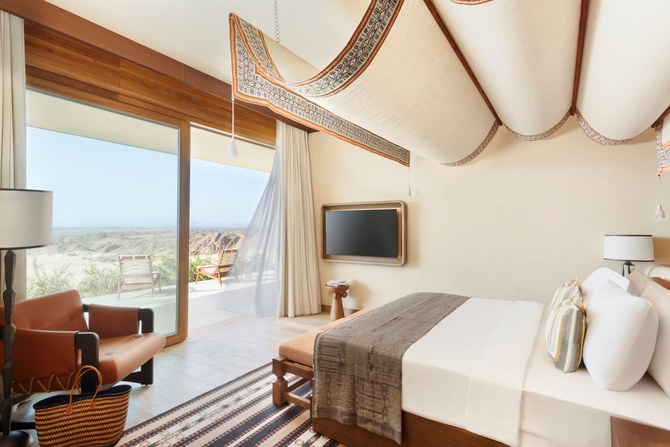
DUBAI: For those planning their next staycation, two hotels in Saudi Arabia have found a spot in Conde Nast’s prestigious annual Hot List, with one of them located in the heart of Riyadh.
The St Regis Riyadh and Six Senses Southern Dunes, The Red Sea have joined the list of best hotel openings from the last year, spanning the globe, from Argentina and Zimbabwe to Nepal and Spain, and more.
The St Regis Riyadh is “the only hotel inside Via Riyadh – a bijou mall of designer boutiques, hand-picked restaurants, and a cinema complex, wrapped within monumental sandstone walls at the edge of the Saudi capital’s Diplomatic Quarter – the St Regis Riyadh nods to the hotel brand’s New York heritage as well as its new Saudi home,” according to the publication.

Meanwhile, the new Six Senses Southern Dunes, The Red Sea, is the first resort to open in the 28,000-square-kilometer expanse of sea, reefs, islands and inland desert known, simply, as The Red Sea. It’s one of Saudi Arabia’s ambitious tourism-focused giga-projects, part of the Kingdom’s Vision 2030 aimed at diversifying the economy and heralding a new future for the nation.
Eid escapes: A guide to relaxing holiday destinations in the Kingdom
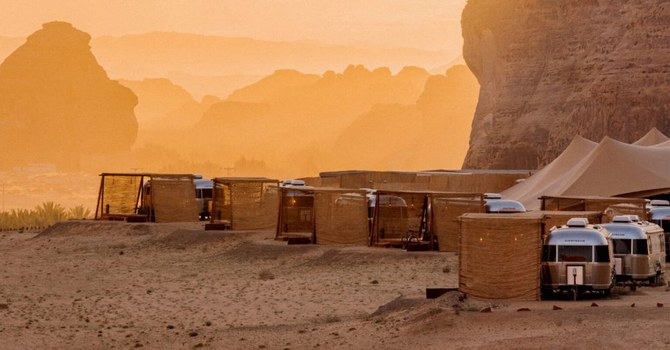
- Saudi Arabia’s diverse landscapes beckon adventurers to explore its natural wonders
- Saudi Arabia’s renowned tourism project, The Red Sea, is welcoming guests with the opening of The St. Regis Red Sea Resort
JEDDAH: After a month of worship, many people during Eid Al-Fitr break seek fun and relaxation. For those looking for a serene and rejuvenating destination, Saudi Arabia offers an array of options. From luxury resorts to sustainable desert getaways, the Kingdom provides diverse choices to suit all preferences.
Here is a curated list of destinations for a perfect Eid getaway.
The St. Regis Red Sea Resort
Saudi Arabia’s renowned tourism project, The Red Sea, is welcoming guests with the opening of The St. Regis Red Sea Resort. Situated on the Ummahat Islands in the Al-Wajh Lagoon, this luxurious resort features 90 beachfront and overwater villas, each boasting private pools and stunning views. Designed by architect Kengo Kuma, the resort’s aesthetic reflects the beauty of coral reefs and dunes. Guests can dine al fresco at five beachside venues and enjoy Japanese-inspired cuisine at Gishiki 45 and Tilina. The resort offers a spa, gym, and outdoor lap pool, all powered by renewable energy. Rates start from $1,866 per night.
Six Senses Southern Dunes
Nestled amid rolling dunes and the Hijaz Mountains, Six Senses Southern Dunes offers a unique retreat. With rooms, suites, and villas designed under tent-like roofs, the resort blends modern luxury with traditional charm. Guests can enjoy spacious accommodations with outdoor terraces and private pools. The resort’s spa spans 4,000 square feet and offers a range of treatments. Activities include cooking classes and fishing tours, and dining options cater to diverse palates. Rates start from SR4,380 ($1,168) for a Wadi King Room, with a commitment to sustainability.
AlUla: A haven of history and natural beauty
Located in the northwest of Saudi Arabia, AlUla is renowned for its rich history, stunning landscapes, and archaeological wonders. Home to UNESCO World Heritage Sites like the Nabatean tombs at Hegra and ancient rock art, AlUla offers visitors a glimpse into ancient civilizations. The region is undergoing extensive development to enhance its tourism infrastructure while preserving its cultural heritage and natural beauty.
Here are some top accommodations in AlUla for an unforgettable Eid escape experience:
Habitas AlUla: A sustainable desert resort offering luxury accommodations amid the desert canyons of the Ashar Valley, Habitas AlUla features 96 guest villas, each designed to blend seamlessly with the surrounding landscape. Guests can enjoy a range of facilities, including wellness centers, dining options, and a large infinity swimming pool.
Caravan by Habitas AlUla: Caravan provides a unique luxury camping experience in the picturesque Ashar Valley with exclusive Airstream trailers offering either an oasis or mountainous view. Each of the 22 deluxe trailers features panoramic views, air conditioning, WiFi, a queen-size bed (or two single beds), an indoor lounge, a kitchenette, and a private shower and bathroom. Prices range from SR1500 to SR2500 per night.
Ashar Tented Resort: Nestled amid the sweeping desert sands and rugged rock formations of the Ashar Valley, this luxury camping experience immerses guests in AlUla’s spectacular scenery. With access to five-star facilities at the neighboring Banyan Tree Hotel, guests can enjoy a comfortable and memorable stay.
Banyan Tree AlUla: Offering breathtaking views of the Ashar Valley, Banyan Tree AlUla features 47 elegant tented villas adorned with authentic Arabian-inspired details. Committed to sustainability and well-being, the resort advocates for environmental conservation and cultural preservation.
Whether you seek luxury, tranquility, or cultural immersion, AlUla offers a range of experiences to suit every traveler’s preference.
Explore the region’s rich history, breathtaking landscapes, and unparalleled hospitality for an unforgettable Eid getaway: www.experiencealula.com.
Adventures and sightseeing
Many seek the perfect getaway to unwind and connect with nature. In Saudi Arabia, adventure-seekers have a plethora of options thanks to the diverse terrains that span the Kingdom. From sandy deserts to rugged mountains and lush valleys, there is something for everyone to explore.
Guiding adventurers across the Kingdom
Saudi Trips, a leading adventure agency, offers a range of trips and hikes across the Kingdom. Founded by Ibrahim Saad, the agency aims to provide visitors with the best Eid experience, tailored to their preferences and budget.
Saad highlights some of the prime camping and hiking spots, including the iconic AlUla region, the mysterious Dark Cave in Tabuk, and the picturesque Wadi Al-Disah in Jazan.
“In my opinion, the best destinations during Eid break are the sandy areas, caves, and valleys,” Saad told Arab News. “Activities vary according to the terrain, including walking on the sand, mountain climbing, and descending.”
Other notable destinations Saad mentioned include Lajab Valley, the Caravans Trail along the Tuwaiq Mountains, Thumama, and Mount Qarah in the Eastern Province.
Happy escape
For those seeking a unique experience, Ahway, a Saudi tourism project, offers well-equipped caravans in scenic locations. Founded by Saeed Azhar, Ahway aims to promote local tourism while providing visitors with a chance to disconnect from city life and immerse themselves in nature. Starting in Taif, the project plans to expand to other regions like AlUla and Tabuk, offering guests a chance to explore Saudi Arabia’s stunning landscapes.
Diverse landscapes
Khalid Al-Rabiah, CEO of Ghamra Adventures Agency, spoke to Arab News about the allure of Saudi Arabia’s diverse landscapes during Eid.
“Being in a large city like Riyadh, the nearby areas, especially Thadiq National Park and the dunes and valleys of Rughabah Village, are considered prime destinations for Eid escape, especially with their unique nature and the presence of hiking trails and mountain ridges spanning over 70 km.
“There is also a growing trend of camping in the unique natural environments of Hail and Tabuk, known for their peculiar mountains with strange formations and golden sands.”
Ali Al-Abdali, a tour guide in Jazan, describes the region as a haven for hiking and wilderness enthusiasts not only for the Eid holiday but throughout the year.
From stunning beaches along the Red Sea to rugged mountains like Al-Ardah and Al-Rayth, Jazan offers diverse landscapes for outdoor activities.
As Eid approaches, Saudi Arabia’s natural attractions beckon adventurers, both local and international, to explore and create unforgettable memories amid breathtaking scenery.
Bulgaria, Romania take first steps into Europe’s visa-free zone

- New status will not apply to land routes, after Austria veto over fears of a potential influx of asylum seekers
- Schengen zone will now comprise 29 members, including 25 EU member states plus Switzerland, Norway, Iceland and Liechtenstein
BUCHAREST: Bulgaria and Romania joined Europe’s vast Schengen area of free movement on Sunday, opening up travel by air and sea without border checks after a 13-year wait.
A veto by Austria, however, means the new status will not apply to land routes, after Vienna expressed concerns over a potential influx of asylum seekers.
Despite the partial membership, the lifting of controls at the two countries’ air and sea borders is of significant symbolic value.
Admission to Schengen is an “important milestone” for Bulgaria and Romania, symbolizing a “question of dignity, of belonging to the European Union,” according to foreign policy analyst Stefan Popescu.
“Any Romanian who had to walk down a lane separate from other European citizens felt being treated differently,” he told AFP.
Ivan Petrov, a 35-year-old Bulgarian marketing executive who lives in France, said he was enthusiastic about less stressful traveling and the time he would be able to save.
“This is a great success for both countries, and a historic moment for the Schengen area — the largest area of free movement in the world,” EU chief Ursula von der Leyen said in a statement Saturday.
“Together, we are building a stronger, more united Europe for all our citizens.”
With Bulgaria and Romania arriving joining Sunday, the Schengen zone will comprise 29 members — 25 of the 27 European Union member states as well as Switzerland, Norway, Iceland and Liechtenstein.
Romania’s government said Schengen rules would apply to four sea ports and 17 airports, with the country’s Otopeni airport near the capital Bucharest serving as the biggest hub for Schengen flights.
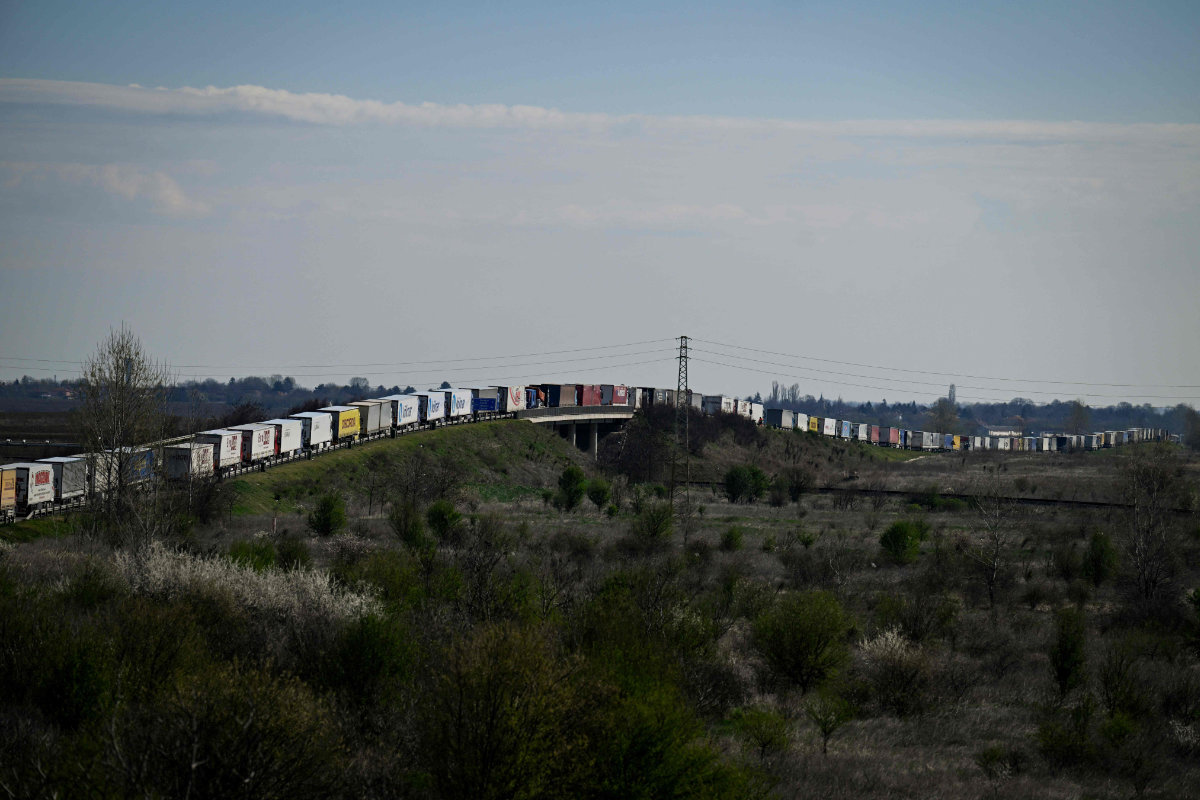
More staff including border police and immigration officers will be deployed to airports to “support passengers and detect those who want to take advantage to leave Romania illegally,” it added.
Random checks will also be carried out to catch people with false documents and to combat human trafficking.
Bulgaria and Romania both hope to fully integrate into Schengen by the end of the year, but Austria has so far relented only on air and sea routes.
Croatia, which joined the EU after Romania and Bulgaria, beat them to becoming Schengen’s 27th member in January 2023.
Created in 1985, the Schengen area allows more than 400 million people to travel freely without internal border controls.
While some have reason to celebrate, truck drivers, faced with endless queues at the borders with their European neighbors, feel left out.
Earlier this month, one of Romania’s main road transport unions the UNTRR called for “urgent measures” to get full Schengen integration, deploring the huge financial losses caused by the long waits.
“Romanian hauliers have lost billions of euros every year, just because of long waiting times at borders,” secretary general Radu Dinescu said.
According to the union, truckers usually wait eight to 16 hours at the border with Hungary, and from 20 to 30 hours at the Bulgarian border, with peaks of three days.
Bulgarian businesses have also voiced their anger over the slow progress.
“Only three percent of Bulgarian goods are transported by air and sea, the remaining 97 percent by land,” said Vasil Velev, president of the Bulgarian Industrial Capital Association (BICA).
“So we’re at three percent in Schengen and we don’t know when we’ll be there with the other 97 percent,” he told AFP.
Bucharest and Sofia have both said that there will be no going back.
“There is no doubt that this process is irreversible,” Romanian Interior Minister Catalin Predoiu said this month, adding it “must be completed by 2024 with the extension to land borders.”













